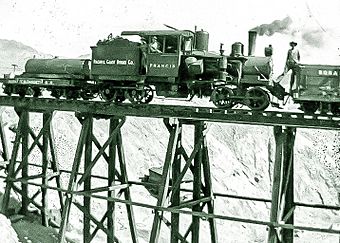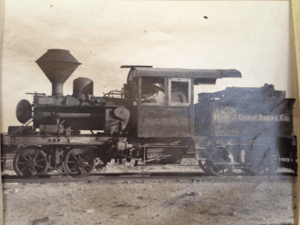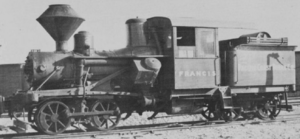Borate and Daggett Railroad facts for kids

Borate & Daggett Railroad train on high trestle just before Borate, engine is #2 "Francis"
|
|
| Overview | |
|---|---|
| Headquarters | Daggett, California |
| Locale | Daggett, California to Borate, California |
| Dates of operation | 1898–1907 |
| Technical | |
| Track gauge | 3 ft (914 mm) |
The Borate and Daggett Railroad was a special kind of train track. It was a narrow gauge railroad, meaning its tracks were closer together than regular train tracks. This railroad was built to carry a mineral called borax across the Mojave Desert. It stretched for about 11 miles (18 km) from Daggett, California, all the way to a mining town called Borate. Borate was about 3 miles (5 km) east of Calico.
Contents
History of the Borate and Daggett Railroad
Discovering Borax in the Desert
In 1883, explorers found a lot of colemanite borax in the Calico Mountains. This was about 4 miles (6 km) east of the silver mining town of Calico. A rich businessman named William Tell Coleman bought this discovery. He already owned several borax mines in Death Valley. One of his famous mines was the Harmony Borax Works. This mine was known for its Twenty-mule teams. These teams of mules pulled huge wagons filled with borax to the train tracks in Mojave, California.
In 1890, Coleman faced financial difficulties. His business partner, Francis Marion Smith, then bought all of Coleman's borax businesses. Smith created a new company called the Pacific Coast Borax Company. He wanted to use the borax found near Calico, which was now called "Borate," as his company's main source of income. By 1899, the Borate mine had become the biggest borax mine in the world. It produced about 22,000 short tons (20,000 metric tons) of borax from many different mine shafts.
From Mules to Steam Trains
At first, twenty-mule teams were used to carry the borax to the train station in Daggett, California. But Francis Marion Smith wasn't happy with how much it cost to keep the mules and wagons. He also didn't like the effort it took. In 1894, he tried to replace them with a steam tractor. This tractor was nicknamed "Old Dinah." However, "Dinah" wasn't very good at working in the desert.
After two years, "Dinah" was retired. Smith then decided to build a narrow-gauge railroad between Borate and Daggett. The railroad was finished in 1898. It used two special steam locomotives made by Heisler. These engines were named "Marion" and "Francis," after Francis Marion Smith himself. They were used to pull the borax ore.

They also built a roasting mill halfway along the railroad. This mill was also named "Marion." The small engines brought the ore to this mill. There, the ore was heated (roasted) and then put into burlap bags. A special third rail was added to the mill. This allowed regular-sized (standard gauge) boxcars to come right to the mill. This way, less time was wasted moving the borax between the narrow-gauge and standard-gauge trains.
The End of the Borate Railroad
By 1904, the quality of the borax ore from the Borate mine started to get worse. Francis Marion Smith immediately began looking for a new source of borax in Death Valley. He soon found the Lila C. Mine. This new mine was over 142 miles (229 km) north of Daggett.
Smith ordered the building of the Tonopah and Tidewater Railroad. This new railroad would carry the ore from the Lila C. Mine to the closest train connection in Ludlow, California. As soon as the Tonopah & Tidewater Railroad reached the Lila C. Mine in October 1907, all mining at Borate stopped. The Borate & Daggett Railroad was then abandoned.
Most of the railroad tracks were taken up and sold for scrap metal. The two locomotives and the other train cars were left on a small side track in Daggett. This track was next to the main Santa Fe railroad line. They weren't used again until 1913. At that time, the Pacific Coast Borax Company needed narrow-gauge train equipment to help build the Death Valley Railroad.

Once that work was done, the old Heisler locomotives finished their working days. They spent their last years helping in the timber fields of Oregon and northern California.

